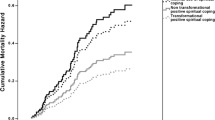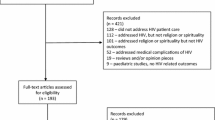Abstract
Background
Most studies on religion/spirituality predicting health outcomes have been limited to church attendance as a predictor and have focused on healthy people. However, confronting a major medical crisis may be a time when people turn to the sacred.
Objective
The purpose of this study was to determine the extent to which changes in spirituality/religiousness occur after HIV diagnosis and whether changes predict disease progression.
Design/participants
This longitudinal study examined the relationship between changes in spirituality/religiousness from before with after the diagnosis of HIV, and disease progression (CD4 and viral load [VL] every 6 months) over 4 years in 100 people with HIV. Measures included change in religiousness/spirituality after diagnosis of HIV, religiousness/spirituality at various times in one’s life, church attendance, depression, hopelessness, optimism, coping (avoidant, proactive), social support, CD4/VL, and health behaviors.
Results
Forty-five percent of the sample showed an increase in religiousness/spirituality after the diagnosis of HIV, 42% remained the same, and 13% decreased. People reporting an increase in spirituality/religiousness after the diagnosis had significantly greater preservation of CD4 cells over the 4-year period, as well as significantly better control of VL. Results were independent of (i.e., held even after controlling for) church attendance and initial disease status (CD4/VL), medication at every time point, age, gender, race, education, health behaviors (adherence, risky sex, alcohol, cocaine), depression, hopelessness, optimism, coping (avoidant, proactive), and social support.
Conclusions
There is an increase in spirituality/religiousness after HIV diagnosis, and this increase predicts slower disease progression; medical personnel should be aware of its potential importance.
Similar content being viewed by others
References
Powell LH, Shahabi L, Thoresen CE. Religion and spirituality linkages to physical health. Am Psychol. 2003:58:36–52.
McCullough ME, Hoyt WT, Larson DB, Koenig HG, Thoresen C. Religious involvement and mortality: a meta-analytic review. Health Psychol. 2000:19:211–22.
Kirkpatrick L. Attachment, Evolution and the Psychology of Religion. New York: Guilford Press; 2005.
Leserman J, Petitto JM, Gu H, et al. Progression to AIDS, a clinical AIDS condition and mortality: psychosocial and physiological predictors. Psychol Med. 2002;32:1059–73.
Ironson G, O’Cleirigh C, Fletcher MA, et al. Psychosocial factors predict CD4 and viral load change in men and women in the era of HAART. Psychosomat Med. 2005:67:1013–21.
Ironson G, Balbin E, Stuetzle R, et al. Dispositional optimism and the mechanisms by which it predicts slower disease progression in HIV: proactive behavior, avoidant coping, and depression. Int J Behav Med (Special Issue on Positive Psychology). 2005:12:86–97.
Koenig HG. Psychoneuroimmunology and the faith factor. J Gender-Specific Med. 2000;3:37–44.
Ironson G, Solomon G, Balbin E, O’Cleirigh C, George A. The ironsonwoods spirituality/religiousness index is associated with long survival. health behaviors, less distress, and low cortisol in people with HIV/AIDS. Ann Behav Med. 2002;24:34–48.
Simoni JM, Ortiz MZ. Mediational models of spirituality and depressive symptomatology among HIV-positive Puerto Rican women. Cultural Diversity Ethnic Minority Psychol. 2003;9:3–15.
Chesney MA, Ickovics JR, Chambers DB, et al. Patient care committee & adherence working group of the adult aids clinical trials group. Self reported adherence to antiretroviral medications among participants in HIV clinical trials: the AACTG adherence instruments. AIDS Care. 2000;12:255–66.
Beck AT, Ward CH, Mendelson M, Mock J, Erbaugh J. An inventory for measuring depression. Arch Gen Psychiatry. 1961;4:561–71.
Beck AT, Weissman A, Lester D, Trexler L. The measurement of pessimism: the hopelessness scale. J Consult Clin Psychol. 1974;42:861–5.
Scheler MF, Carver CS. Optimism, coping, and health: assessment and implication of generalized outcome expectancies. Health Psychol. 1985;4:219–47.
Scheler MF, Carver CS, Bridges MW. Distinguishing optimism from neuroticism (and trait anxiety, self-mastery and self-esteem): a re-evaluation of the Life Orientation Test. J Pers Soc Psychol. 1994;67:1063–78.
Carver CS, Scheier MF, Weintraub JK. Assessing coping strategies: a theoretically based approach. J Pers Soc Psychol. 1989;56:267–83.
Ironson G, Friedman A, Klimas N, et al. Distress, denial, and low adherence to behavioral interventions predict faster disease progression in gay men infected with human immunodeficiency virus. Int J Behav Med. 1994;1:90–105.
Mitchell PH, Powell L, Blumenthal J, et al. A short social support measure for patients recovering from myocardial infarction: the ENRICHD social support inventory. J Cardiopulm Rehab. 2003:23:398–403.
Bryk AS, Raudenbush SW. Hierarchical Linear Models: Applications and Data Analysis Methods. 2nd ed. Thousand Oaks, CA: Sage; 2002.
Tsevat J, Sherman SN, McElwee JA, et al. The will to live among HIV-infected patients. Ann Intern Med. 1999:131:194–8.
Jacobson CJ, Luckhaupt S, Delaney S, Tsevat J. Religio-biography, coping, and meaning-making among persons with HIV/AIDS. J Sci Stud Relig. 2006:45:39–56.
Ironson G, Kremer H, Ironson D. Spirituality, spiritual experiences, and spiritual transformations in the face of HIV. In: Koss-Chiono J, Hefner P, eds. Spiritual Transformation and Healing: Anthropological. Religious, Neuroscientific, and Clinical Perspectives, Walnut Creek, CA: Altamira Press; 2006:241.
Cotton S, Tsevat J, Szaflarski M, et al. Religious and spiritual experiences of people with HIV. J Gen Intern Med. 2006:21:s5–13.
Schneiderman N, Ironson G, Siegel S. Stress and health: psychological, behavioral, and biological determinants. Ann Rev Clin Psychol. 2005:607–28.
Segerstrom SC, Miller GE. Psychological stress and the human immune system: a meta-analysis of 30 years of inquiry. Psychol Bull. 2004: 130:601–30.
Cole SW, Korin YD, Fahey JL, Zack JA. Norepinephrine accelerates HIV replication via protein kinase A-dependent effects on cytokine production. J Immunol. 1998;161:610–6.
Ironson G, Balbin E, Solomon G, et al. Relative preservation of natural killer cell cytotoxicity and number in healthy AIDS patients with low CD4 counts. AIDS. 2001;15:2065–73.
Hill P, Pargament K. Advances in the conceptualization and measurement of religion and spirituality. Implications for physical and mental health research. Am Psychol. 2003;58:64–74.
Woods TE, Ironson G. Religion and spirituality in the face of illness: how cancer, cardiac, and HIV patients describe their spirituality/religicsity. J Health Psychol. 1999;4:393–412.
Pargament KI, Koenig HG, Perez L. The many methods of religious coping: development and validation of the RCOPE. J Clini Psychol. 2000;56:519–43.
Pargament KI, Koenig HG, Tarakeshwar N, Hahn J. Religious struggle as a predictor of mortality among medically ill elderly patients: a two year longitudinal study. Arch Intern Med. 2001;161:1881–5.
Kristeller JL, Rhodes M, Cripe LD, Sheets V. Oncologist assisted spiritual intervention study (OASIS): patient acceptability and initial evidence of effects. Int J Psychiatr Med. 2005;35:329–47.
Psychiatric Annals Special Issue: Spirituality in Psychiatric Practice: Guidelines for assessing and managing religious and spiritual issues. March 2006; 137–204.
Author information
Authors and Affiliations
Corresponding author
Additional information
The authors have no conflicts of interest to declare.
Rights and permissions
About this article
Cite this article
Ironson, G., Stuetzle, R. & Fletcher, M.A. An increase in religiousness/spirituality occurs after HIV diagnosis and predicts slower disease progression over 4 years in people with HIV. J GEN INTERN MED 21 (Suppl 5), S62–S68 (2006). https://doi.org/10.1111/j.1525-1497.2006.00648.x
Issue Date:
DOI: https://doi.org/10.1111/j.1525-1497.2006.00648.x




